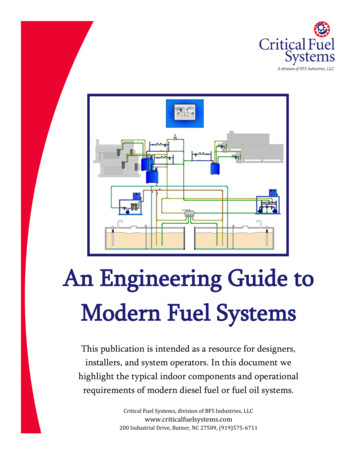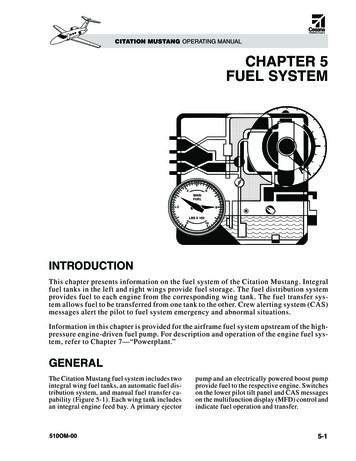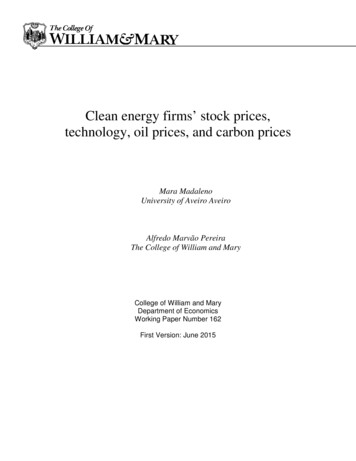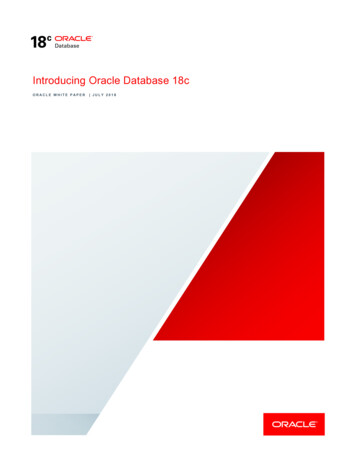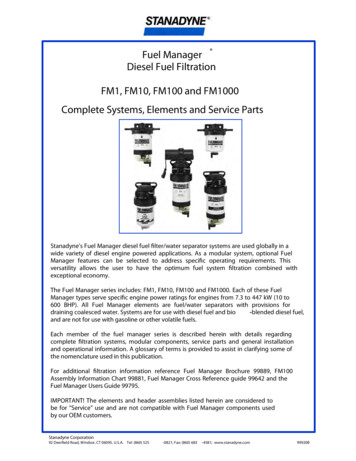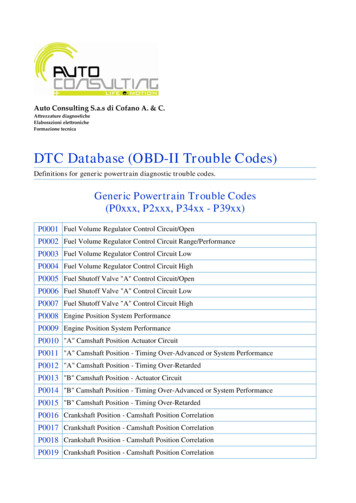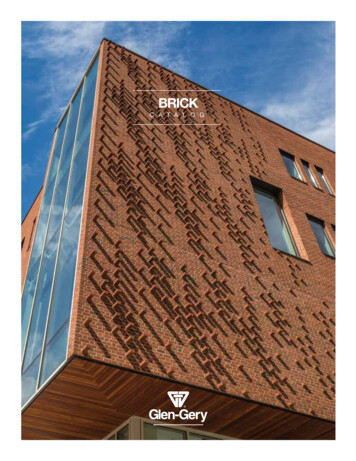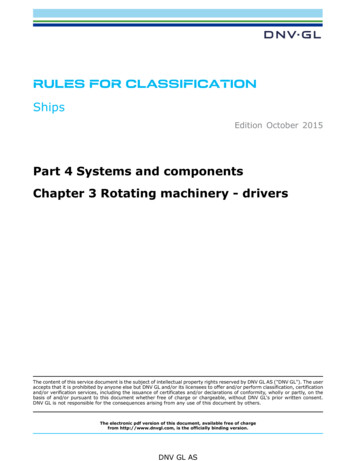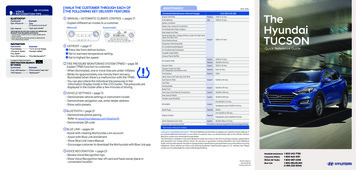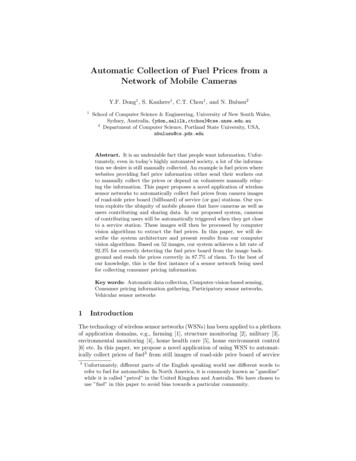
Transcription
Automatic Collection of Fuel Prices from aNetwork of Mobile CamerasY.F. Dong1 , S. Kanhere1 , C.T. Chou1 , and N. Bulusu21School of Computer Science & Engineering, University of New South Wales,Sydney, Australia, {ydon,salilk,ctchou}@cse.unsw.edu.au2Department of Computer Science, Portland State University, USA,nbulusu@cs.pdx.eduAbstract. It is an undeniable fact that people want information. Unfortunately, even in today’s highly automated society, a lot of the information we desire is still manually collected. An example is fuel prices wherewebsites providing fuel price information either send their workers outto manually collect the prices or depend on volunteers manually relaying the information. This paper proposes a novel application of wirelesssensor networks to automatically collect fuel prices from camera imagesof road-side price board (billboard) of service (or gas) stations. Our system exploits the ubiquity of mobile phones that have cameras as well asusers contributing and sharing data. In our proposed system, camerasof contributing users will be automatically triggered when they get closeto a service station. These images will then be processed by computervision algorithms to extract the fuel prices. In this paper, we will describe the system architecture and present results from our computervision algorithms. Based on 52 images, our system achieves a hit rate of92.3% for correctly detecting the fuel price board from the image background and reads the prices correctly in 87.7% of them. To the best ofour knowledge, this is the first instance of a sensor network being usedfor collecting consumer pricing information.Key words: Automatic data collection, Computer-vision-based sensing,Consumer pricing information gathering, Participatory sensor networks,Vehicular sensor networks1IntroductionThe technology of wireless sensor networks (WSNs) has been applied to a plethoraof application domains, e.g., farming [1], structure monitoring [2], military [3],environmental monitoring [4], home health care [5], home environment control[6] etc. In this paper, we propose a novel application of using WSN to automatically collect prices of fuel3 from still images of road-side price board of service3Unfortunately, different parts of the English speaking world use different words torefer to fuel for automobiles. In North America, it is commonly known as ”gasoline”while it is called ”petrol” in the United Kingdom and Australia. We have chosen touse ”fuel” in this paper to avoid bias towards a particular community.
stations. To the best of our knowledge, this is the first instance of a WSN beingused for collecting consumer pricing information.Price dispersion of homogenous goods appears to be a fixture of our economy.It is not uncommon for us to find two shops within a close proximity selling anidentical item at different prices. For instance, on 18 January 2008, around 9pm,two service stations in Roseville, Sydney, that are less than 1 km apart, wereselling unleaded fuel at 1.359 and 1.439 Australian dollars per litre. With thepresence of price dispersion, the availability of consumer pricing information cantherefore be advantageous and this has been confirmed by a number of studiesby economists on the effect of information on the on-line economy. For example,the study in [7] showed that consumers who used on-line price comparison service could save up to 16% in buying electronic goods on-line. Also, the on-lineeconomy has also been shown to drive down insurance prices in [8].Given the existence of price dispersion in fuel, a number of websites exist toenable consumers to compare fuel prices. Examples of these include Gaswatch,GasBuddy4 in the United States; fuelprice 5 in the UK; RACV, fuelwatch andmotormouth6 in Australia. These websites use a couple of different methods tocollect their fuel price data. Some of these websites send their workers out, onceor twice a day, to collect the data; however, this is labour intensive and it isdifficult to track price changes since different service stations update their priceat different times of the day7 . Some other websites rely on volunteers manuallyrelaying the fuel price information. Although the use of volunteers can providemore frequent updates, the need to manually relay the fuel price data may discourage many people from volunteering. Are there other alternatives other thanmanual collection? One possibility is deploying infrastructure at each servicestation to monitor the prices; however, the capital investment can be costly.Given the above discussion, we therefore see the efficient collection of fuelprice information (or more generally of a lot of information at the street level)to be a technical challenge. We believe that a method to overcome this technicalchallenge is to use the Sensing Data Market (SenseMart) framework that theauthors of this paper have proposed in [9]. The SenseMart framework consistsof two key ideas. Firstly, it leverages the existing sensing and communicationsinfrastructure in collecting sensing data. Secondly, it provides a platform forpeople to exchange and share sensing data. This paper proposes a WSN architecture that allows volunteers to automatically collect, contribute and share fuelprice information, thus lowering the cost or barrier for sharing. Our proposedsystem (which will be detailed in Sect.2) leverages on the ubiquity of cameras,4567http://www.gaspricewatch.com, ov.au/,http://motormouth.com.au/default nf.aspxPrice of fuel does change a few times a day at many service stations across Sydney.
mobile Internet connectivity, GPS (Global Positioning System) and GIS (Geographic Information System). Through the use of GPS and GIS, our systemknows that when the vehicle of a contributing user is getting close to a servicestation and triggers the camera automatically. These images are then processedby a computer vision algorithm to extract the fuel price, the details of whichwill be described in Sect.3 and 4.There are several applications, which largely rely on the altruistic participation of users, such as Wikipedia, Youtube and BitTorrent,and yet have becomehugely popular. Their success can be attributed to the following characteristics:(1) easy to use software for uploading, sharing and searching data and (2) insignificant monetary costs for uploads/downloads. The preliminary version ofour system presented in this paper focusses on addressing the former. In thecurrent incarnation, the computer vision algorithms are executed at a centralserver and the users are required to upload the raw images. Our ultimate goalis to accomplish all image processing tasks on the mobile device. Consequently,users would only have to upload a few bits of data, thus lowering the monetarybarrier for information sharing.This paper makes the following contributions:– We propose a new application of WSN to collect consumer pricing information.– We propose a novel WSN architecture — whose components include cameras,mobile phones, GPS, GIS, computer vision algorithms as well as the sharingof sensing data — that can automatically collect fuel prices from images ofservice station, thus lowering the barrier of sharing sensing data.– We implemented a working prototype which automatically detects and classifies fuel prices from images of service station billboards. Based on 52 images,our system achieves a hit rate of 92.3% for correctly detecting the fuel priceboard from the image background and reads the prices correctly for 87.7%of them.2System DesignOur system has two principal modes of operation: (i) fuel price collection and (ii)user query. In this paper, we primarily focus on the former. The most importantgoal of our system is to automate the process of collecting the fuel prices. This isachieved by automatically triggering the mobile phones of contributing users totake pictures of roadside fuel price boards when they approach service stationswhile driving. Our system employs sophisticated computer vision algorithms toscan these images and retrieve the fuel prices. To reduce the complexity of thecomputer vision tasks, our system relies on contextual information that is madeavailable by GPS and GIS software. Figure 1(a) presents a pictorial overview ofour system. As depicted in the picture, the data collection process involves threesteps: (i) capturing images of the fuel price boards, (ii) uploading the images tothe central server and (iii) extracting fuel prices from the images . Each of thesetasks is executed by a distinct component of the system. In the following, we
discuss the design and implementation of the three main components that makeup our system and describe their operation.Camera Sensor: The primary function of the camera sensor is to automatically capture images of the price boards of approaching service stations. In oursystem, we have assumed that the mobile phones of contributing users will servethis purpose. Note that, almost all current mobile phones are equipped within-built cameras. We assume that the phone is mounted on the dashboard infront of the front passenger, with the camera lens pointing towards the road, i.e.leftwards. Consequently, the camera can capture pictures of roadside objects onthe left of the car (Note that in Australia we drive on the left side of the road). Inthe future, it is expected that cars would be fitted with cameras for implementedsophisticated ITS (Intelligent Transport System) applications. Our system canbe readily interfaced with these in-car cameras. In this instance, the images captured by the cameras could be transferred wirelessly via Wifi or Bluetooth tothe mobile phone.Figure 1(b) depicts a logical representation of the various components thatcontribute to realizing the automated capturing of images. The control unit,which oversees the operation is implemented as a daemon in the mobile phone.The control unit periodically polls the in-built GPS receiver of the phone toobtain the current location coordinates of the car. It should be noted that a largemajority of the new mobile phones are equipped with GPS receivers. Alternately,it is fairly straightforward to connect an external GPS receiver to a phone viaBluetooth. Our system also requires that GIS software such as Google Maps,TomTom or Nokia Maps is installed on the phone. GIS systems use the GPSlocation coordinates and a map database of the city road network to estimatethe current street position of the mobile. GIS systems can also call to attentionany approaching Points of Interest (POI) such as restaurants, shopping mallsand service stations. For example, TomTom alerts users of approaching servicestations and also indicates the provider information (i.e. brand, e.g.: Caltex,Mobil, etc). Our system takes advantage of these capabilities of the GIS softwarefor automating the data collection process. The control unit queries the GISsystem to obtain the location coordinates and the brand of the next approachingservice station along the path of the car. Using this location data, the controlunit first determines if the service station is on the appropriate side of the road.Recall, that as explained earlier the mobile phone is mounted with the cameralens facing the left-side of the road. Next it determines if the car is within anacceptable distance for taking pictures (a configurable threshold which is set to10 meters) and then automatically triggers the camera sensor to take severalpictures. The camera is switched off once the car has passed the service station.The images are tagged with contextual information provided by the GPS and GISsoftware such as the service station location coordinates, brand information andtime of capture. This information significantly simplifies the complexity of theimage processing algorithms that are executed at the server. The images togetherwith the meta-data are passed on to the data upload unit, which is responsible
for uploading the pictures to the central server. It is important to note that theentire process is automated and does not require any user intervention.Data Transport: Our system leverages on the existing communication infrastructure for effecting the transfer of images to the server. Current mobilephones have ubiquitous Internet connectivity via the GSM/GPRS/3G/HSDPAcellular network and in some cases also via in-built 802.11 interfaces. The dataupload unit of the mobile phone establishes a TCP connection with the centralserver using any of the available underlying access technologies. The images areuploaded to the server using this reliable channel. An alternative is to uploadthe images as multimedia SMS messages.Central Server: The central server implements the computer vision algorithms for processing the images and extracting the fuel prices. A standarddesktop computer is sufficient for implementing this functionality. We have implemented a TCP server daemon, which receives the images uploaded by themobile users. The meta-data (location coordinates, service station brand andtime) is extracted and stored separately. The images along with the fuel brandinformation are passed on to the image processing engine. Figure 1(c) represents the sequence of steps involved in the price extraction process. The firststep involves detecting the existence of a fuel price board in the image, whichby itself is a significantly challenging task. However, note that, each fuel branduses a specific color combination for their fuel price boards. For example, BPuses a green color code, whereas Mobil boards are blue in color. To reduce thecomplexity of the problem, we utilize the knowledge of the brand of the servicestation to assist in the detection process. Recall that this information is includedas meta-data with the uploaded pictures. For each brand, we employ a tailoredcolor thresholding that is able to capture regions within the images, which havea similar color scheme as that of the price board. In certain situations, surrounding objects within the image may have colors resembling the board resulting inmore than one potential candidate regions, e.g.: the blue sky in the backgroundimage may be similar to the color of the Mobil board. In this situation, we usetwo post-processing techniques to narrow down the search. In the first instance,we make use of certain features of the dimensions of the price boards to excludesome of the candidate regions selected by our color thresholding algorithm. Further refinement is achieved by comparing the color histogram of all candidateregions with that of a sample image of the price board of that particular brand.The detection process concludes with the identification of the precise locationof the price board within the image. The image is then cropped such that itsolely contains the price board. The cropped image is then normalized to a standard size and resolution. The goal of the next step is to extract the individualfuel price characters from the image. To achieve this, we first convert the colorpicture to a binary image and then employ connected component labeling toextract out the individual numeral characters of the fuel prices. The final stepuses a Feedforward Backpropagation Neural Network algorithm for classifyingthe price numeral characters. The neural network utilizes a training templatecontaining numeral characters compiled from a number of sample images of fuel
price boards. A detailed description of all of the aforementioned steps can befound in the subsequent section.Once the prices are extracted they are stored in a database which is linked toa GIS road network database populated with the locations of the service stations.This GIS database is consistent with that installed on the mobile phones. Since,each image is tagged with the time and location, the server updates the fuelprices of the appropriate service station in the database if the current image hasa timestamp later than that of the stored prices. The past history of fuel pricesat each service station is also recorded for analyzing pricing trends.As discussed earlier, this paper primarily focusses on the data collection aspect of our system. We now briefly describe how our system deals with userqueries. The central server implements a simple query resolver daemon for servicing pricing queries from users. A simple client program implemented on themobile phone allows users to query for the cheapest refueling option in theirvicinity. The client program obtains the current location coordinates of the userby querying the GPS receiver. The users’ query tagged with his location information is then sent to the central sever. The server searches the fuel price databasefor the cheapest service station in the vicinity of the user and sends back a replyto the users mobile phone, which contains the price, location coordinates andbrand of the chosen service station. In our future work, we also intend to implement support for more sophisticated queries such as ”find the cheapest fuelstation collocated with a convenience store”. In addition, we plan on providingfor alternate modes of access to the pricing information, such as via SMS and aweb-based interface.(b) Mobile sensor components(a) System assificationFuel pricesRaw image(c) Overview of the computer vision algorithmFig. 1. System design
3Computer Vision Algorithm for Extracting Fuel PricesDespite recent advances, computer vision still can not deal with complex environmental problems, though it can work accurately in controlled environments.In the following we present some of the key environmental challenges that areencountered by our system:1. Some of the pictures may contain extraneous objects that overlap with thefuel price board. For example, in Fig.2(a) 8 a white car has masked the lowerpart of the board.2. The color of some objects in the background may be similar to the colorof the price board, E.g., the blue color of the wall in the background inFig.2(b) is similar to that of the fuel price board. Consequently, the wallmay be wrongly interpreted as the price board if color is used as the keyfeature in the detection process.3. Since the images are captured while in motion, it is likely that some of themappear blurred or unfocussed. Figure 2(c) illustrates one such case.4. Recognition and detection of road signs from digital images is a mature areaof research [10–12]. However, a road sign differs significantly from a fuel priceboard as evidenced by comparing Fig.3(a) and Fig.3(b). A typical image ofa fuel price board not only contains several small characters but also ismore likely to have extraneous objects that could be wrongly interpreted ascharacters. For example, the cropped white label to the left of the price inthe top row may be wrongly interpreted as ”1”. Figure 3(c) illustrates aninstance where all individual characters are successfully extracted.5. Computer vision algorithms used for extracting text from images consist oftwo important steps: (i) Detection of the target area and (ii) Extractionof the characters. It is likely that the quality of the images required forthe successful completion of the individual tasks may vary significantly. Forexample, it may be fairly easy to detect the price board in a particular image.However, the text extraction may fail for the same image.To overcome these and other challenges, our system makes use of certain contextual information by employing the assistance of GPS and GIS. Our algorithmconsists of two key steps, which are described in the subsequent sub-sections.3.1Fuel Price Board DetectionGiven an image, the task of detecting the presence of a fuel board and preciselyidentifying its location is quite difficult to solve with the current state-of-theart in computer vision. Hence, our system relies on GPS and GIS to provideadditional contextual information, which significantly simplifies the problem. As8This and other images in Sect.3 are best viewed on a colour screen. Full size versionsof these images can be found at the following link: http://www.cse.unsw.edu.au/ ydon/dcoss08 images/
(a)(b)(c)Fig. 2. Examples illustrating the challenges encountered by computer vision(a)(b)(c)Fig. 3. Problems encountered in classifying fuel price charactersexplained in Sect.2, the GIS system includes the service station brand as metadata with the image. Each fuel brand uses a specific color combination for itsprice boards, e.g.: BP price boards are green and Mobil boards use blue as thebackdrop. We use this color information as a key feature for isolating objectsin the picture which can be potential fuel price boards. In this paper we haveonly focussed on BP and Mobil, two of the largest fuel providers in Sydney. Inour future work, we intend to encompass all the major providers in Australia.There are two prominent schemes for representing color images: RGB (Red,Green and Blue) and HIS (Hue, Intensity and Saturation). The HIS color spaceis immune to changes in the lighting condition, but is computationally intensivesince it involves nonlinear transformation [10]. On the contrary, RGB is sensitiveto changes in the lighting conditions, but is computationally efficient. Since ourultimate goal is to implement the computer vision algorithms directly on themobile phones, we have chosen to use the RGB color space.Figure 4 depicts the step-by-step evolution of the board detection algorithmfor one particular example image. The original image, containing a Mobil boardthat serves as the input to the detection algorithm is shown in Fig.4(a). We usethe Mobil board which is blue in color as an illustrative example to explain ouralgorithm. A similar logic was used to identify BP boards.Since RGB is an additive color space, a blue component image can be readilyobtained by boosting the blue level of each pixel and subtracting the corresponding green and red components as indicated by (1),B(x, y) 2 fb (x, y) fr (x, y) fg (x, y)(1)
where fb (x, y), fr (x, y) and fg (x, y) are, respectively, the functions representingthe blue, red and green levels of each pixel in the image [10]. Figure 4(b) represents the blue component image of the original image in Fig.4(a). A similarapproach can be employed for other colors.Color thresholding [13] is one of the earliest techniques for detecting objectsin digital images. Thresholding aims to classify all the pixels of an image intoobject pixels, which correspond to regions potentially containing the object andbackground pixels. Since the Mobil board is blue, we employ color thresholdingwith the criteria that a pixel in the blue component image is an object pixel ifB(x, y) exceeds a certain threshold, Bth . The output of the color thresholdingproduces a binary (i.e. black and white) image, with all object pixels taking ona value of 255 (note that, each pixel is represented by 8 bits) and backgroundpixels being zero. The above process can be represented mathematically as,(255, if B(x, y) Bth ,(2)B(x, y) 0,else,In our first attempt at implementing color thresholding, we tried to use a singular value of the threshold Bth , which was calculated using a few test images.However, when we used this value for testing our dataset (details in Sect.4), weobserved very poor results. This was expected given that the RGB color spaceis quite sensitive to lighting conditions. As an improvement we used a set of testimages and manually classified them into 5 distinct groups representing different lighting conditions. We then computed the range of the average intensities(AI) of the blue component images for each group. Next, we determined thevalue of Bth for each group that achieved a 100% positive detection of the priceboard. Table 1 shows the range of AI values for each of the groups and thecorresponding threshold value, Bth .Table 1. Thresholds for images with different average intensitiesAverage Intensity Range AI 3 3 AI 9 9 AI 15 15 AI 70 70 AIBth0205080120Figure 4(c), shows the binary image produced by the color thresholding.Since, each row of the fuel prices is separated by a line, the fuel price board actually appears as three sub-divided regions in the binary image. These adjacentregions are merged together to form the complete price board, as indicated inFig.4(d). Finally, connected component labeling [13] is employed to group thepixels into components based on pixel connectivity, i.e, all pixels in a connectedcomponent share similar pixel intensity values and are in some way connectedwith each other. Figure 4(e) shows the output of the the connected componentlabeling. One can readily observe that it contains several regions, which canbe potential price boards. Our algorithm uses two post-processing techniques,
(a)(b)(c)(d)(e)(f)(g)(h)Fig. 4. Intermediate steps involved in the detection processwhich make use of certain known features (color and dimension) of the fuel priceboards to narrow down the choices and correctly detect the price board.Dimension Comparison: The first step makes use of the a priori knowledgeof the dimensions of a typical price board to exclude regions, which are obviouslyeither too small or too large. However, determining a set of constraints basedon dimensions can be tricky since the pictures are not captured from a staticlocation. The camera can be at variable distances from the price boards whenthe pictures are captured. Further, the orientation of the camera lens relativeto the price board may be different in each image. We have analyzed a set oftest images of the price boards to encompass all these variables. Our test setincludes close-up and far-away views of the price boards and pictures capturedwith the camera lens at different angles to the plane of the price board. Ouranalysis concludes that a candidate region of width Wi and height Hi can onlyqualify as a potential fuel price board, if the following constraints are met:Wi 1 Wimage30Hi 2.5Wi(3)(4)where Wimage is the width of the image containing the candidate region. Figure4(f) is the output of the first post-processing step. As compared to the inputimage in Fig.4(e), the number of candidate regions have now been reduced to 3.Color Histogram Comparison: The second post-processing techniquecompares the histogram distribution of the candidate regions to that of a template of the price board. The Chi square distance [14] between hi , the histogramof the candidate region and hj , the histogram of the price board template is
computed as follows,hi2Khi (m) hj (m)X1χ2 (hi , hj ) 2 m 1 hi (m) hj (m)(5)where K is the number of histogram bins. As χ turns out to be a large number,we normalize this distance as follows,Dnorm χK WI(6)where K is the number of histogram bins and W I is the width of the image.In our system, we set K as 60, since it provides for good accuracy and lowcomplexity. W I is set to the standard value of 480 pixels. To determine anappropriate threshold value for the normalized distance, Dnorm , we used a testset containing 10 cropped images that include the fuel price board and 10 imagesthat do not contain one. The normalized distance of each image in the set wascomputed by comparing its histogram with that of the price board templateusing 6. Based on the test results, we conclude that if a candidate region hasDnorm 2.5, then it is very likely that this region corresponds to the fuel priceboard. Figure 5(a) shows the template used in our tests and Fig.5(d) representsits color histogram. Figure 5(b) is a cropped image from the test set that containsthe fuel price board and its color histogram is plotted in Fig.5(e). Dnorm for thisparticular image is 1.6. Figure 5(c) represents an image from the test set thatdoes not contain the price board and its corresponding histogram is shown inFig.5(f). Dnorm for this image is 3.9, considerably higher than the thresholdof 2.5. Figure 4(h) is the output of applying the histogram comparison. Thefuel price board has now been correctly identified. This concludes the detectionphase. The next step is to extract the fuel prices from the board.3.2Fuel Price ClassificationThe last section describes an algorithm on detecting the fuel price board fromthe background of the image. This section describes the procedure to extract andclassify the numeral characters which make up the fuel prices in a price board.The procedure consists of two steps: extraction of the characters and followedby classification by a neural network.Character extraction: The fuel price boards are usually designed such thatthere is sufficient contrast between the characters and the background color.As a result, an image of the fuel price board does not contain excessive noise.Therefore, it is sufficient for us to use a binary image (instead of full colorimage) for character extraction which can significantly reduce the amount ofprocessing. For character extraction, we employ the bounding box algorithm in[15]. The cropped (or extracted) characters are then normalised to a standardsize of 50-by-70 pixels. For the construction of feature vectors for characterrecognition, we divide each 50-by-70 pixel character into 35 10-by-10 pixel regions
(a)(b)(c)(d)(e)(f)Fig. 5. Color histograms for a few example imagesand compute the average intensity in each region. Thus, each extracted characterwill be represented by a 35 1 feature vector.Character Recognition: For character recognition, we employ the Feedforward Back-propagation Neural Networks (FFBPNN) due to its simple implementation and robustness to interference [16]. The FFBPNN is first trained byusing characters extracted from 20 sample fuel price boards. The feature vectorconstruction procedure is identical to the one described in the last paragraph.Thus, each character in the training set is represented by a 35 1 feature vector.For the identification of fuel type, we have, fo
economy has also been shown to drive down insurance prices in [8]. Given the existence of price dispersion in fuel, a number of websites exist to enable consumers to compare fuel prices. Examples of these include Gaswatch, GasBuddy4 in the United States; fuelprice 5 in the UK; RACV, fuelwatch and motormouth6 in Australia. These websites use a .
